Listeria monocytogenes in Stone Fruits Linked to a Multistate Outbreak: Enumeration of Cells and Whole-Genome Sequencing
- PMID: 27694232
- PMCID: PMC5118914
- DOI: 10.1128/AEM.01486-16
Listeria monocytogenes in Stone Fruits Linked to a Multistate Outbreak: Enumeration of Cells and Whole-Genome Sequencing
Abstract
In 2014, the identification of stone fruits contaminated with Listeria monocytogenes led to the subsequent identification of a multistate outbreak. Simultaneous detection and enumeration of L. monocytogenes were performed on 105 fruits, each weighing 127 to 145 g, collected from 7 contaminated lots. The results showed that 53.3% of the fruits yielded L. monocytogenes (lower limit of detection, 5 CFU/fruit), and the levels ranged from 5 to 2,850 CFU/fruit, with a geometric mean of 11.3 CFU/fruit (0.1 CFU/g of fruit). Two serotypes, IVb-v1 and 1/2b, were identified by a combination of PCR- and antiserum-based serotyping among isolates from fruits and their packing environment; certain fruits contained a mixture of both serotypes. Single nucleotide polymorphism (SNP)-based whole-genome sequencing (WGS) analysis clustered isolates from two case-patients with the serotype IVb-v1 isolates and distinguished outbreak-associated isolates from pulsed-field gel electrophoresis (PFGE)-matched, but epidemiologically unrelated, clinical isolates. The outbreak-associated isolates differed by up to 42 SNPs. All but one serotype 1/2b isolate formed another WGS cluster and differed by up to 17 SNPs. Fully closed genomes of isolates from the stone fruits were used as references to maximize the resolution and to increase our confidence in prophage analysis. Putative prophages were conserved among isolates of each WGS cluster. All serotype IVb-v1 isolates belonged to singleton sequence type 382 (ST382); all but one serotype 1/2b isolate belonged to clonal complex 5.
Importance: WGS proved to be an excellent tool to assist in the epidemiologic investigation of listeriosis outbreaks. The comparison at the genome level contributed to our understanding of the genetic diversity and variations among isolates involved in an outbreak or isolates associated with food and environmental samples from one facility. Fully closed genomes increased our confidence in the identification and comparison of accessory genomes. The diversity among the outbreak-associated isolates and the inclusion of PFGE-matched, but epidemiologically unrelated, isolates demonstrate the high resolution of WGS. The prevalence and enumeration data could contribute to our further understanding of the risk associated with Listeria monocytogenes contamination, especially among high-risk populations.
Copyright © 2016 Chen et al.
Figures



References
-
- Centers for Disease Control and Prevention. 2015. Multistate outbreak of listeriosis linked to Blue Bell Creameries products (final update). Centers for Disease Control and Prevention, Atlanta, GA: http://www.cdc.gov/listeria/outbreaks/ice-cream-03-15/.
-
- Centers for Disease Control and Prevention. 2015. Multistate outbreak of listeriosis linked to commercially produced, prepackaged caramel apples made from Bidart Bros. apples (final update). Centers for Disease Control and Prevention, Atlanta, GA: http://www.cdc.gov/listeria/outbreaks/caramel-apples-12-14/.
-
- Heiman KE, Garalde VB, Gronostaj M, Jackson KA, Beam S, Joseph L, Saupe A, Ricotta E, Waechter H, Wellman A, Adams-Cameron M, Ray G, Fields A, Chen Y, Datta A, Burall L, Sabol A, Kucerova Z, Trees E, Metz M, Leblanc P, Lance S, Griffin PM, Tauxe RV, Silk BJ. 2015. Multistate outbreak of listeriosis caused by imported cheese and evidence of cross-contamination of other cheeses, USA, 2012. Epidemiol Infect 144:2698–2708. doi:10.1017/S095026881500117X. - DOI - PMC - PubMed
Publication types
MeSH terms
LinkOut - more resources
Full Text Sources
Other Literature Sources
Medical

